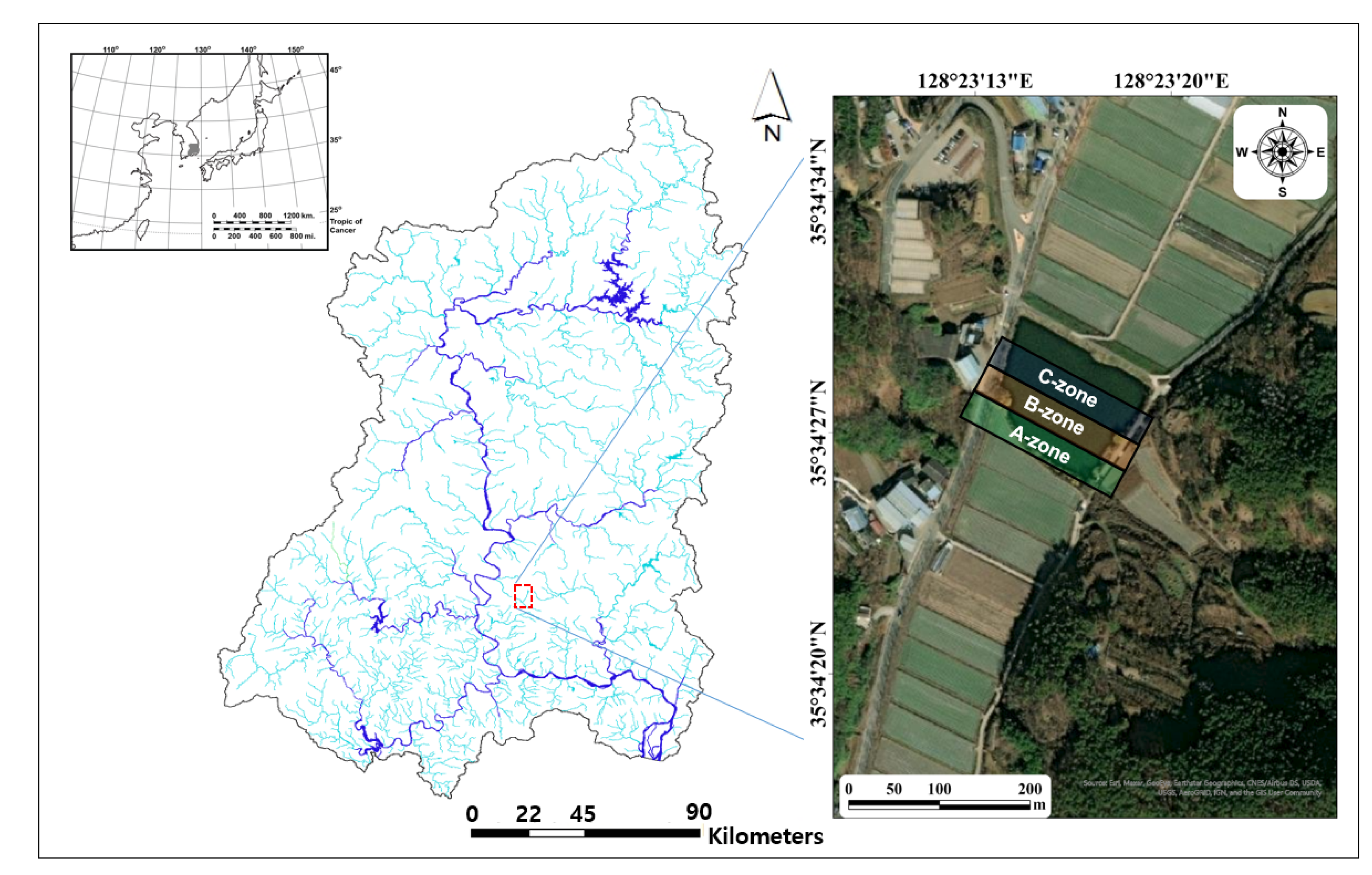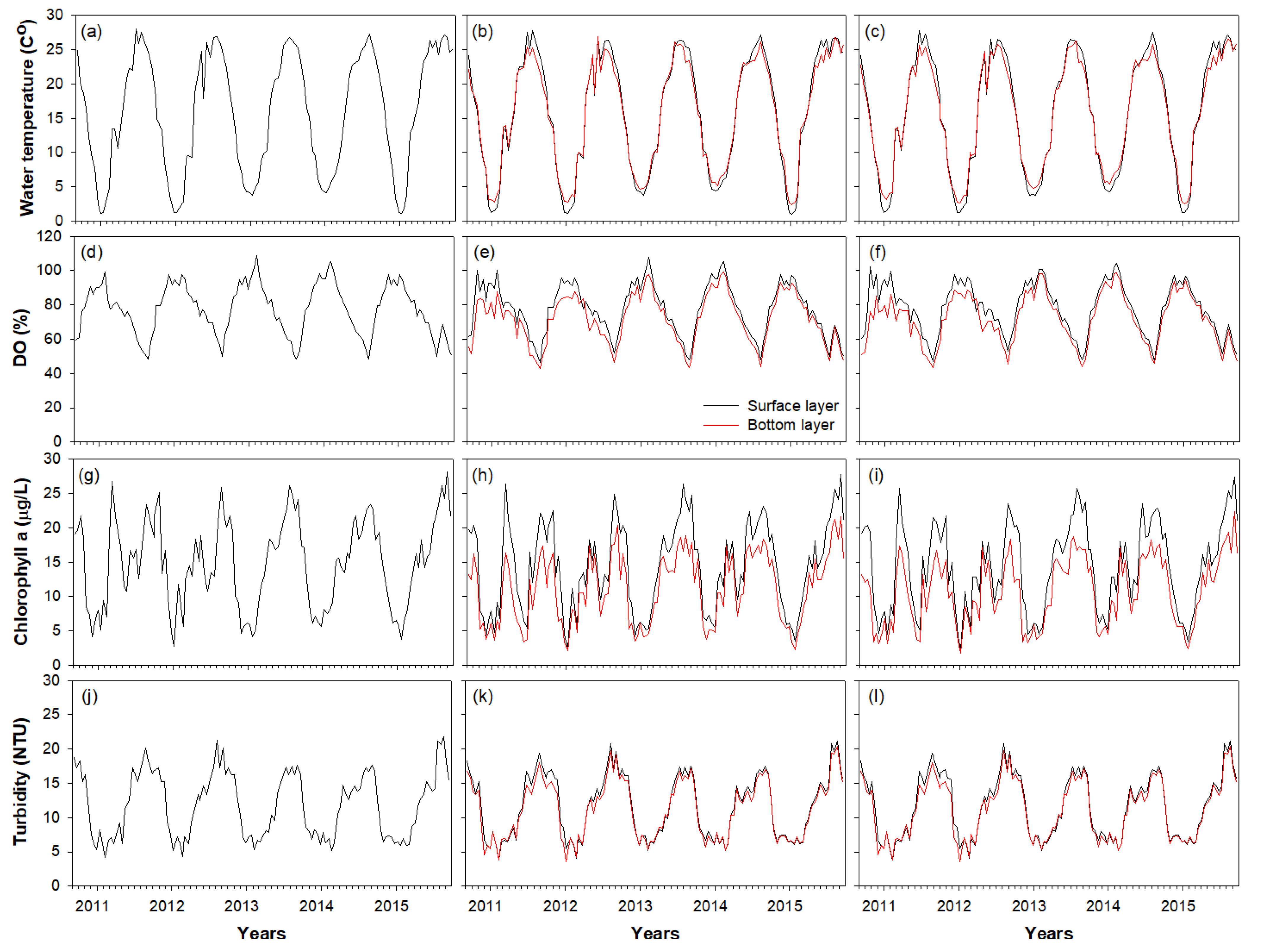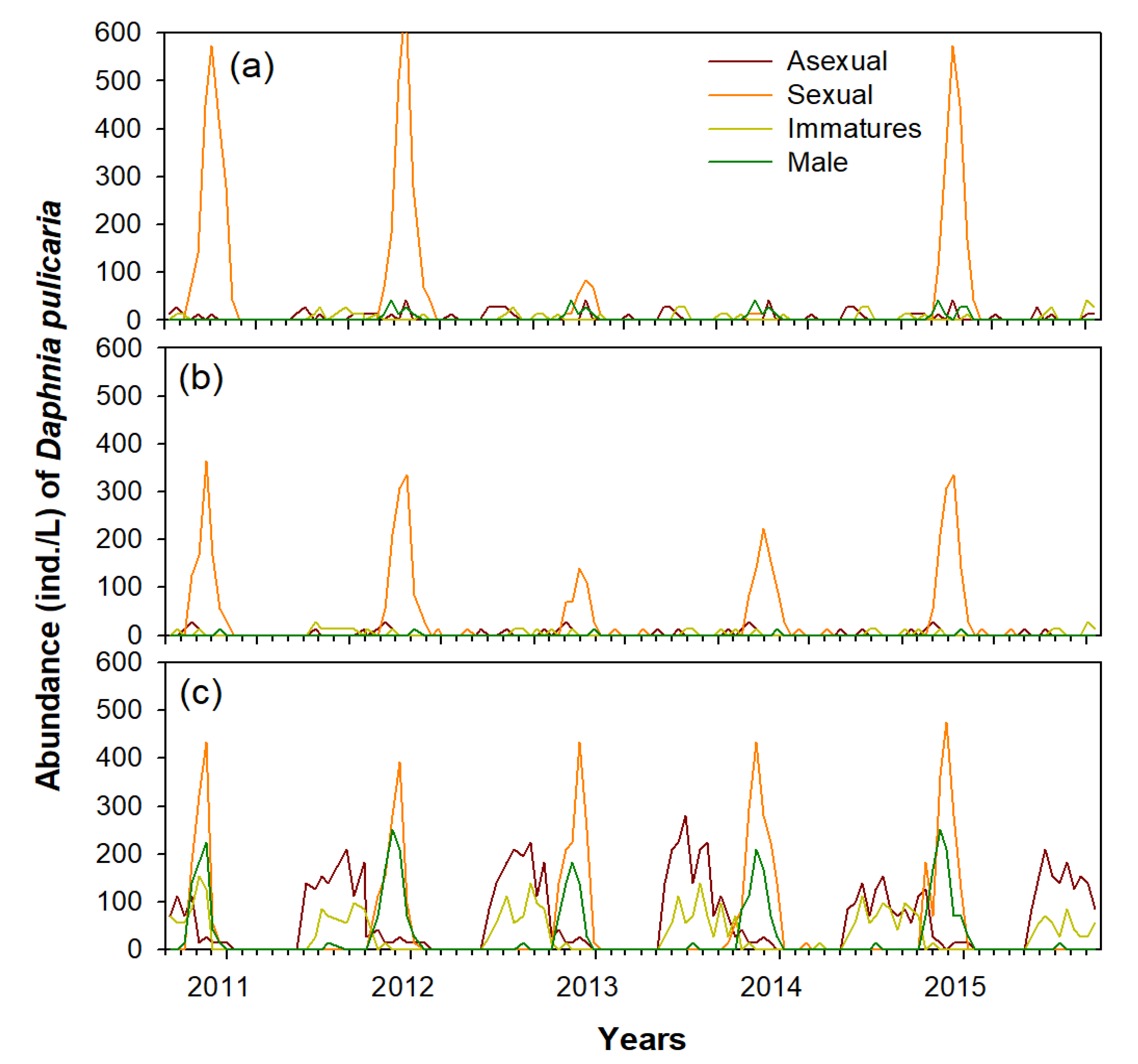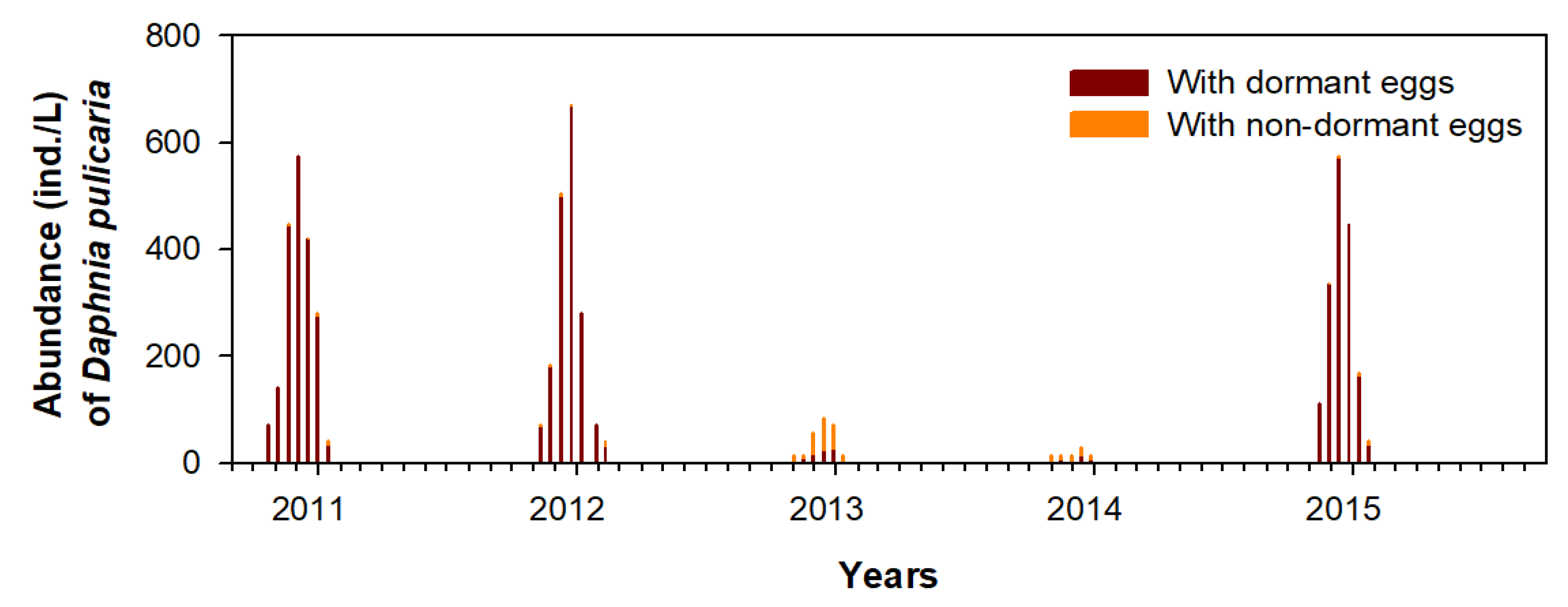Behavioral Avoidance Response of Daphnia to Fungal Infection Caused by Metschnikowia Species in a Temperate Reservoir
Abstract
:Simple Summary
Abstract
1. Introduction
2. Materials and Methods
2.1. Study Area
2.2. Field Survey
2.3. Microcosm Experiments
2.4. Data Analysis
3. Results
3.1. Environmental Variables and D. pulicaria
3.2. Distribution Pattern of Infected Individuals
3.3. Seasonal Distribution of Fish Community
3.4. Hatching and Infection Rates in Dormant Eggs
4. Discussion
4.1. Spatial Distribution of Daphnia pulicaria
4.2. Winter Migration of Infected Hosts
4.3. Evolutionary Strategies to Prevent Horizontal Fungal Infections
5. Conclusions
Author Contributions
Funding
Institutional Review Board Statement
Informed Consent Statement
Data Availability Statement
Conflicts of Interest
References
- Stock, C.A.; Dunne, J.P.; John, J.G. Global-scale carbon and energy flows through the marine planktonic food web: An analysis with a coupled physical–biological model. Prog. Oceanogr. 2014, 120, 1–28. [Google Scholar] [CrossRef]
- Mougi, A. Diversity of biological rhythm and food web stability. Biol. Lett. 2021, 17, 20200673. [Google Scholar] [CrossRef] [PubMed]
- Freitas, A.A.; Rocha, B. Population biology of lymphocytes: The flight for survival. Annu. Rev. Immunol. 2000, 18, 83–111. [Google Scholar] [CrossRef] [PubMed]
- Knight, T.M.; Chase, J.M.; Goss, C.W.; Knight, J.J. Effects of interspecific competition, predation, and their interaction on survival and development time of immature Anopheles quadrimaculatus. J. Vector Ecol. 2004, 29, 277–284. [Google Scholar]
- Claesson, M.J.; Cusack, S.; O’Sullivan, O.; Greene-Diniz, R.; de Weerd, H.; Flannery, E.; Marchesi, J.R.; Falush, D.; Dinan, T.; Fitzgerald, G.; et al. Composition, variability, and temporal stability of the intestinal microbiota of the elderly. Proc. Natl. Acad. Sci. USA 2011, 108 (Suppl. 1), 4586–4591. [Google Scholar] [CrossRef]
- Sih, A.; Bolnick, D.I.; Luttbeg, B.; Orrock, J.L.; Peacor, S.D.; Pintor, L.M.; Preisser, E.; Rehage, J.S.; Vonesh, J.R. Predator–prey naïveté, antipredator behavior, and the ecology of predator invasions. Oikos 2010, 119, 610–621. [Google Scholar] [CrossRef]
- Yoshida, T.; Jones, L.E.; Ellner, S.P.; Fussmann, G.F.; Hairston, N.G. Rapid evolution drives ecological dynamics in a predator–prey system. Nature 2003, 424, 303–306. [Google Scholar] [CrossRef]
- Snell-Rood, E.C. An overview of the evolutionary causes and consequences of behavioural plasticity. Anim. Behav. 2013, 85, 1004–1011. [Google Scholar] [CrossRef]
- Van Baalen, M.; Křivan, V.; van Rijn, P.C.; Sabelis, M.W. Alternative food, switching predators, and the persistence of predator-prey systems. Am. Nat. 2001, 157, 512–524. [Google Scholar] [CrossRef]
- Wen, J.; Ueno, T. Predator cue-induced plasticity of morphology and behavior in planthoppers facilitate the survival from predation. Sci. Rep. 2021, 11, 16760. [Google Scholar] [CrossRef]
- Santangelo, J.M.; Soares, B.N.; Paes, T.; Maia-Barbosa, P.; Tollrian, R.; Bozelli, R.L. Effects of vertebrate and invertebrate predators on the life history of Daphnia similis and Moina macrocopa (Crustacea: Cladocera). Ann. Limnol. -Int. J. Lim. 2018, 54, 25. [Google Scholar] [CrossRef]
- Choi, J.Y.; Kim, S.K. Effects of aquatic macrophytes on spatial distribution and feeding habits of exotic fish species Lepomis macrochirus and Micropterus salmoides in shallow reservoirs in South Korea. Sustainability 2020, 12, 1447. [Google Scholar] [CrossRef]
- Gliwicz, M.Z.; Pijanowska, J. Effect of predation and resource depth distribution on vertical migration of zooplankton. Bull. Mar. Sci. 1988, 43, 695–709. [Google Scholar]
- Meerhoff, M.; Iglesias, C.; De Mello, F.T.; Clemente, J.M.; Jensen, E.; Lauridsen, T.L.; Jeppesen, E. Effects of habitat complexity on community structure and predator avoidance behaviour of littoral zooplankton in temperate versus subtropical shallow lakes. Freshw. Biol. 2007, 52, 1009–1021. [Google Scholar] [CrossRef]
- Antón-Pardo, M.; Muška, M.; Jůza, T.; Vejříková, I.; Vejřík, L.; Blabolil, P.; Čech, M.; Draštík, V.; Frouzová, J.; Holubová, M.; et al. Diel changes in vertical and horizontal distribution of cladocerans in two deep lakes during early and late summer. Sci. Total Environ. 2021, 751, 141601. [Google Scholar] [CrossRef]
- Horppila, J.; Eloranta, P.; Liljendahl-Nurminen, A.; Niemistö, J.; Pekcan-Hekim, Z. Refuge availability and sequence of predators determine the seasonal succession of crustacean zooplankton in a clay-turbid lake. Aquat. Ecol. 2009, 43, 91–103. [Google Scholar] [CrossRef]
- Sakamoto, M.; Chang, K.H.; Hanazato, T. Inhibition of development of anti-predator morphology in the small cladoceran Bosmina by an insecticide: Impact of an anthropogenic chemical on prey–predator interactions. Freshw. Biol. 2006, 51, 1974–1983. [Google Scholar] [CrossRef]
- Choi, J.Y.; Kim, S.K.; La, G.H.; Chang, K.H.; Kim, D.K.; Jeong, K.Y.; Park, M.S.; Joo, G.J.; Kim, H.W.; Jeong, K.S. Effects of algal food quality on sexual reproduction of Daphnia magna. Ecol. Evol. 2016, 6, 2817–2832. [Google Scholar] [CrossRef]
- Mayeli, S.M.; Nandini, S.; Sarma, S.S.S. The efficacy of Scenedesmus morphology as a defense mechanism against grazing by selected species of rotifers and cladocerans. Aquat. Ecol. 2005, 38, 515–524. [Google Scholar] [CrossRef]
- Zhu, S.; Wu, G.; Gu, L.; Sun, Y.; Zhang, L.; Huang, Y.; Lyu, K.; Yang, Z. Antidepressant sertraline impairs the induced morphological defense of Ceriodaphnia cornuta in response to Chaoborus larvae kairomone. Environ. Pollut. 2020, 266, 115092. [Google Scholar] [CrossRef]
- Liu, Q.; Liu, L.; Huang, J.; Gu, L.; Sun, Y.; Zhang, L.; Lyu, K.; Yang, Z. The response of life history defense of cladocerans under predation risk varies with the size and concentration of microplastics. J. Hazard. Mater. 2022, 427, 127913. [Google Scholar] [CrossRef]
- Regoes, R.R.; Hottinger, J.W.; Sygnarski, L.; Ebert, D. The infection rate of Daphnia magna by Pasteuria ramosa conforms with the mass-action principle. Epidemiol. Infect. 2003, 131, 957–966. [Google Scholar] [CrossRef]
- Frost, P.C.; Ebert, D.; Smith, V.H. Bacterial infection changes the elemental composition of Daphnia magna. J. Anim. Ecol. 2008, 77, 1265–1272. [Google Scholar] [CrossRef]
- Ebert, D.; Duneau, D.; Hall, M.D.; Luijckx, P.; Andras, J.P.; Du Pasquier, L.; Ben-Ami, F. A population biology perspective on the stepwise infection process of the bacterial pathogen Pasteuria ramosa in Daphnia. Adv. Parasitol. 2016, 91, 265–310. [Google Scholar]
- Hobaek, A.; Larsson, P. Sex determination in Daphnia magna. Ecology 1990, 71, 2255–2268. [Google Scholar] [CrossRef]
- Kleiven, O.T.; Larsson, P.; Hobæk, A. Direct distributional response in Daphnia pulex to a predator kairomone. J. Plankton Res. 1996, 18, 1341–1348. [Google Scholar] [CrossRef]
- Hall, S.R.; Knight, C.J.; Becker, C.R.; Duffy, M.A.; Tessier, A.J.; Cáceres, C.E. Quality matters: Resource quality for hosts and the timing of epidemics. Ecol. Lett. 2009, 12, 118–128. [Google Scholar] [CrossRef]
- Sánchez, K.F.; Huntley, N.; Duffy, M.A.; Hunter, M.D. Toxins or medicines? Phytoplankton diets mediate host and parasite fitness in a freshwater system. Proc. R. Soc. Lond. B Biol. Sci. 2019, 286, 20182231. [Google Scholar] [CrossRef]
- Narr, C.F.; Ebert, D.; Bastille-Rousseau, G.; Frost, P.C. Nutrient availability affects the prevalence of a microsporidian parasite. J. Anim. Ecol. 2019, 88, 579–590. [Google Scholar] [CrossRef]
- Vale, P.F.; Stjernman, M.; Little, T.J. Temperature-dependent costs of parasitism and maintenance of polymorphism under genotype-by-environment interactions. J. Evol. Biol. 2008, 21, 1418–1427. [Google Scholar] [CrossRef]
- Alva-Martínez, A.F.; Sarma, S.S.S.; Nandini, S. Effect of mixed diets (cyanobacteria and green algae) on the population growth of the cladocerans Ceriodaphnia dubia and Moina macrocopa. Aquat. Ecol. 2007, 41, 579–585. [Google Scholar] [CrossRef]
- Martin-Hernandez, R.; Meana, A.; Garcia-Palencia, P.; Marin, P.; Botias, C.; Garrido-Bailon, E.; Barrios, L.; Higes, M. Effect of temperature on the biotic potential of honeybee microsporidia. Appl. Environ. Microbiol. 2009, 75, 2554–2557. [Google Scholar] [CrossRef] [PubMed]
- Tellenbach, C.; Tardent, N.; Pomati, F.; Keller, B.; Hairston, N.G.; Wolinska, J.; Spaak, P. Cyanobacteria facilitate parasite epidemics in Daphnia. Ecology 2016, 97, 3422–3432. [Google Scholar] [CrossRef] [PubMed] [Green Version]
- Manzi, F.; Agha, R.; Lu, Y.; Ben-Ami, F.; Wolinska, J. Temperature and host diet jointly influence the outcome of infection in a Daphnia-fungal parasite system. Freshw. Biol. 2020, 65, 757–767. [Google Scholar] [CrossRef]
- Duffy, M.A. Staying alive: The post-consumption fate of parasite spores and its implications for disease dynamics. Limnol. Oceanogr. 2009, 54, 770–773. [Google Scholar] [CrossRef]
- Prchalová, M.; Kubečka, J.; Čech, M.; Frouzová, J.; Draštík, V.; Hohausová, E.; Jůza, T.; Kratochvíl, M.; Matěna, J.; Peterka, J.; et al. The effect of depth, distance from dam and habitat on spatial distribution of fish in an artificial reservoir. Ecol. Freshw. Fish 2009, 18, 247–260. [Google Scholar] [CrossRef]
- Fels, D.; Lee, V.A.; Ebert, D. The impact of microparasites on the vertical distribution of Daphnia magna. Arch. Hydrobiol. 2004, 161, 65–80. [Google Scholar] [CrossRef]
- Schoebel, C.N.; Tellenbach, C.; Spaak, P.; Wolinska, J. Temperature effects on parasite prevalence in a natural hybrid complex. Biol. Lett. 2011, 7, 108–111. [Google Scholar] [CrossRef]
- Salathé, M.; Jones, J.H. Dynamics and control of diseases in networks with community structure. PLoS Comput. Biol. 2010, 6, e1000736. [Google Scholar] [CrossRef]
- Davies, N.B.; Bourke, A.F.; Brooke, M.D.L. Cuckoos and parasitic ants: Interspecific brood parasitism as an evolutionary arms race. Trends Ecol. Evol. 1989, 4, 274–278. [Google Scholar] [CrossRef]
- Lively, C.M.; Craddock, C.; Vrijenhoek, R.C. Red Queen hypothesis supported by parasitism in sexual and clonal fish. Nature 1990, 344, 864–866. [Google Scholar] [CrossRef]
- Kerfoot, W.C.; Weider, L.J. Experimental paleoecology (resurrection ecology): Chasing Van Valen’s Red Queen hypothesis. Limnol. Oceanogr. 2004, 49 Pt 2, 1300–1316. [Google Scholar] [CrossRef]
- Moritz, C.; McCallum, H.; Donnellan, S.; Roberts, J.D. Parasite loads in parthenogenetic and sexual lizards (Heteronotia binoei): Support for the Red Queen hypothesis. Proc. R. Soc. Lond. B Biol. Sci. 1991, 244, 145–149. [Google Scholar]
- Blader, I.J.; Saeij, J.P. Communication between Toxoplasma gondii and its host: Impact on parasite growth, development, immune evasion, and virulence. Apmis 2009, 117, 458–476. [Google Scholar] [CrossRef] [Green Version]
- Burks, R.L.; Lodge, D.M.; Jeppesen, E.; Lauridsen, T.L. Diel horizontal migration of zooplankton: Costs and benefits of inhabiting the littoral. Freshw. Biol. 2002, 47, 343–365. [Google Scholar] [CrossRef]
- Muška, M.; Tušer, M.; Frouzová, J.; Draštík, V.; Čech, M.; Jůza, T.; Kratochvíl, M.; Mrkvička, T.; Peterka, J.; Prchalová, M.; et al. To migrate, or not to migrate: Partial diel horizontal migration of fish in a temperate freshwater reservoir. Hydrobiologia 2013, 707, 17–28. [Google Scholar] [CrossRef]
- Wetzel, R.G.; Likens, G.E. Composition and biomass of phytoplankton. In Limnological Analyses; Springer: New York, NY, USA, 2000; pp. 147–174. [Google Scholar]
- Haney, J.F.; Hall, D.J. Sugar-coated Daphnia: A preservation technique for Cladocera 1. Limnol. Oceanogr. 1973, 18, 331–333. [Google Scholar] [CrossRef]
- Mizuno, T.; Takahashi, E. An Illustrated Guide to Freshwater Zooplankton in Japan; Tokai University Press: Tokyo, Japan, 1999; p. 532. [Google Scholar]
- Thorp, J.H.; Covich, A.P. Ecology and Classification of North American Freshwater Invertebrates; Academic Press: Cambridge, MA, USA, 2009. [Google Scholar]
- Yin, M.; Laforsch, C.; Lohr, J.N.; Wolinska, J. Predator-induced defense makes Daphnia more vulnerable to parasites. Evolution 2011, 65, 1482–1488. [Google Scholar] [CrossRef]
- Civitello, D.J.; Forys, P.; Johnson, A.P.; Hall, S.R. Chronic contamination decreases disease spread: A Daphnia–fungus–copper case study. Proc. R. Soc. B Biol. Sci. 2012, 279, 3146–3153. [Google Scholar] [CrossRef]
- Kim, I.S.; Park, J.Y. Freshwater Fish of Korea; Kyo Hak Publishing: Seoul, Korea, 2002. (In Korean) [Google Scholar]
- Nelson, J.S.; Grande, T.C.; Wilson, M.V. Fishes of the World; John Wiley & Sons: Hoboken, NJ, USA, 2016. [Google Scholar]
- Hopp, U.; Maier, G.; Bleher, R. Reproduction and adult longevity of five species of planktonic cyclopoid copepods reared on different diets: A comparative study. Freshw. Biol. 1997, 38, 289–300. [Google Scholar] [CrossRef]
- Hurlbert, S.H. Pseudoreplication and the design of ecological field experiments. Ecol. Monogr. 1984, 54, 187–211. [Google Scholar] [CrossRef]
- Zar, J.H. Biostatistical Analysis; Pearson Education India: Bangalore, India, 1999. [Google Scholar]
- Sokal, R.R.; Rohlf, F.J. Biostatistics; Francise & Co: New York, NY, USA, 1987. [Google Scholar]
- Taiwo, O.P. The role of abiotic factors in diurnal vertical distribution of zooplankton in Awba Dam, Ibadan, Nigeria. J. Nat. Sci. Res. 2014, 4, 2224–3186. [Google Scholar]
- Yang, Y.; Gao, Y.; Chen, Y.; Li, S.; Zhan, A. Interactome-based abiotic and biotic impacts on biodiversity of plankton communities in disturbed wetlands. Divers. Distrib. 2019, 25, 1416–1428. [Google Scholar] [CrossRef]
- Lemke, A.M.; Stoeckel, J.A.; Pegg, M.A. Utilization of the exotic cladoceran Daphnia lumholtzi by juvenile fishes in an Illinois River floodplain lake. J. Fish Biol. 2003, 62, 938–954. [Google Scholar] [CrossRef]
- Butts, T.J.; Hodgson, J.Y.; Guidone, M.; Hodgson, J.R. Episodic zooplanktivory by largemouth bass (Micropterus salmoides) on Daphnia: A 25-year natural history record from a small northern temperate lake. J. Freshw. Ecol. 2020, 35, 469–490. [Google Scholar] [CrossRef]
- Romare, P.; Berg, S.; Lauridsen, T.; Jeppesen, E. Spatial and temporal distribution of fish and zooplankton in a shallow lake. Freshw. Biol. 2003, 48, 1353–1362. [Google Scholar] [CrossRef]
- Kurek, J.; Weeber, R.C.; Smol, J.P. Environment trumps predation and spatial factors in structuring cladoceran communities from Boreal Shield lakes. Can. J. Fish. Aquat. Sci. 2011, 68, 1408–1419. [Google Scholar] [CrossRef]
- Adamczuk, M. Spatial distribution of juvenile and adult stages of limnetic Cladocera in relation to selected environmental factors. J. Limnol. 2012, 71, 112–118. [Google Scholar] [CrossRef]
- Lin, Q.; Zhao, P.; Wu, Q.; Wei, Z.; Li, H.; Han, B.P. Predation pressure induced by seasonal fishing moratorium changes the dynamics of subtropical Cladocera populations. Hydrobiologia 2013, 710, 73–81. [Google Scholar] [CrossRef]
- Muluk, C.B.; Beklioglu, M. Absence of typical diel vertical migration in Daphnia: Varying role of water clarity, food, and dissolved oxygen in Lake Eymir, Turkey. Hydrobiologia 2005, 537, 125–133. [Google Scholar] [CrossRef]
- Kim, S.K.; Choi, J.Y. Differences in the vertical distribution of two cladoceran species in the Nakdong River estuary, South Korea. Water 2020, 12, 2154. [Google Scholar] [CrossRef]
- Burks, R.L.; Jeppesen, E.; Lodge, D.M. Macrophyte and fish chemicals suppress Daphnia growth and alter life-history traits. Oikos 2000, 88, 139–147. [Google Scholar] [CrossRef]
- Meerhoff, M.; Fosalba, C.; Bruzzone, C.; Mazzeo, N.; Noordoven, W.; Jeppesen, E. An experimental study of habitat choice by Daphnia: Plants signal danger more than refuge in subtropical lakes. Freshw. Biol. 2006, 51, 1320–1330. [Google Scholar] [CrossRef]
- Choi, J.Y.; Jeong, K.S.; Kim, S.K.; La, G.H.; Chang, K.H.; Joo, G.J. Role of macrophytes as microhabitats for zooplankton community in lentic freshwater ecosystems of South Korea. Ecol. Inform. 2014, 24, 177–185. [Google Scholar] [CrossRef]
- Silva, E.D.S.; Rocha, O.; Santos-Wisniewski, M.J.D. Diel vertical migration of Cladocera in a compartment of a tropical reservoir. Acta Limnol. Bras. 2018, 30. [Google Scholar] [CrossRef] [Green Version]
- Cross, B.K.; Taylor, T.N.; Moore, B.C.; Lanouette, B.P. Zooplankton and profundal macroinvertebrate responses to hypolimnetic oxygenation in North Twin Lake, Washington. Lake Reserv. Manag. 2021, 37, 275–288. [Google Scholar] [CrossRef]
- Decker, M.B.; Breitburg, D.L.; Purcell, J.E. Effects of low dissolved oxygen on zooplankton predation by the ctenophore Mnemiopsis leidyi. Mar. Ecol. Prog. Ser. 2004, 280, 163–172. [Google Scholar] [CrossRef]
- Alajärvi, E.; Horppila, J. Diel variations in the vertical distribution of crustacean zooplankton and food selection by planktivorous fish in a shallow turbid lake. Int. Rev. Hydrobiol. 2004, 89, 238–249. [Google Scholar] [CrossRef]
- Schulze, P.C. Evidence that fish structure the zooplankton communities of turbid lakes and reservoirs. Freshw. Biol. 2011, 56, 352–365. [Google Scholar] [CrossRef]
- Adamczuk, M. Population dynamics and life history traits of Daphnia magna across thermal regimes of environments. Sci. Total Environ. 2020, 723, 137963. [Google Scholar] [CrossRef]
- Decaestecker, E.; Meester, L.D.; Mergeay, J. Cyclical parthenogenesis in Daphnia: Sexual versus asexual reproduction. In Lost Sex; Schön, I., Martens, K., Dijk, P., Eds.; Springer: Dordrecht, The Netherlands, 2009; pp. 295–316. [Google Scholar]
- Kagami, M.; Van Donk, E.; De Bruin, A.; Rijkeboer, M.; Ibelings, B.W. Daphnia can protect diatoms from fungal parasitism. Limnol. Oceanogr. 2004, 49, 680–685. [Google Scholar] [CrossRef]
- Von Elert, E.; Pohnert, G. Predator specificity of kairomones in diel vertical migration of Daphnia: A chemical approach. Oikos 2000, 88, 119–128. [Google Scholar] [CrossRef]
- Duffy, M.A.; Hunsberger, K.K. Infectivity is influenced by parasite spore age and exposure to freezing: Do shallow waters provide Daphnia a refuge from some parasites? J. Plankton Res. 2019, 41, 12–16. [Google Scholar] [CrossRef]







| Year | Month | A-Zone | B-Zone (Surface) | B-Zone (Bottom) | C-Zone (Surface) | C-Zone (Bottom) | |||||
|---|---|---|---|---|---|---|---|---|---|---|---|
| Day | Night | Day | Night | Day | Night | Day | Night | Day | Night | ||
| 2010 | September | 42 ± 6.3 | 40 ± 5.2 | - | - | 14 ± 4.2 | 11 ± 1.5 | - | - | 168 ± 14 | 164 ± 23 |
| October | 70 ± 5.2 | 73 ± 8.3 | - | - | 154 ± 13 | 149 ± 15 | 14 ± 1.6 | 12 ± 1.1 | 518 ± 25 | 520 ± 21 | |
| November | 448 ± 20 | 451 ± 18 | - | - | 364 ± 24 | 355 ± 21 | 28 ± 6.7 | 31 ± 7.2 | 812 ± 30 | 809 ± 26 | |
| December | 420 ± 23 | 426 ± 21 | - | - | 70 ± 9.4 | 58 ± 10 | 14 ± 3.6 | 16 ± 2.4 | 42 ± 5.1 | 37 ± 20 | |
| 2011 | January | 42 ± 6.3 | 48 ± 6.3 | - | - | - | - | - | - | - | - |
| September | 28 ± 3.2 | 25 ± 8.2 | 14 ± 2.3 | 15 ± 2.5 | 14 ± 2.1 | 16 ± 4.2 | 14 ± 2.2 | 14 ± 2.3 | 210 ± 8 | 205 ± 16 | |
| October | 14 ± 1.6 | 10 ± 2.1 | - | - | 14 ± 1.8 | 15 ± 3.6 | - | 98 ± 6.3 | 93 ± 11 | ||
| November | 84 ± 9.2 | 80 ± 6.3 | - | - | 84 ± 6.5 | 79 ± 2.7 | 14 ± 2.7 | 14 ± 2.7 | 350 ± 12 | 346 ± 15 | |
| December | 518 ± 16 | 511 ± 25 | - | - | 308 ± 16 | 286 ± 18 | 28 ± 2.6 | 28 ± 2.4 | 630 ± 19 | 621 ± 31 | |
| 2012 | January | 294 ± 13 | 284 ± 21 | - | - | 98 ± 11 | 93 ± 8.2 | 14 ± 3.1 | 14 ± 2.6 | 56 ± 6.7 | 52 ± 3.4 |
| Years | Fish Species | Winter (January) | Spring (May) | Summer (August) | Autumn (October) | ||||
|---|---|---|---|---|---|---|---|---|---|
| A | C | A | C | A | C | A | C | ||
| 2010 | M. salmoides | 1 | 2 | 2 | |||||
| L. macrochirus | 1 | 2 | 2 | 2 | |||||
| P. parva | 1 | 1 | |||||||
| 2011 | M. salmoides | 2 | 1 | 2 | |||||
| L. macrochirus | 2 | 1 | 1 | ||||||
| P. parva | |||||||||
| 2012 | M. salmoides | 1 | 2 | 1 | |||||
| L. macrochirus | 1 | 1 | 1 | 1 | |||||
| P. parva | |||||||||
| 2013 | M. salmoides | 1 | 1 | ||||||
| L. macrochirus | 1 | 3 | 1 | 2 | |||||
| P. parva | 1 | ||||||||
| 2014 | M. salmoides | 1 | 2 | 3 | |||||
| L. macrochirus | 1 | 3 | 3 | 1 | |||||
| P. parva | 1 | 1 | |||||||
| 2015 | M. salmoides | 1 | 1 | 2 | 1 | 1 | 2 | ||
| L. macrochirus | 2 | 3 | 2 | ||||||
| P. parva | 1 | 1 | |||||||
| Factors | Variance | d.f. | F | p |
|---|---|---|---|---|
| Hatching rates (%) | Groups | 2 | 24.516 | <0.001 |
| Beakers | 28 | 0.488 | >0.05 | |
| Infection rates (%) | Groups | 2 | 87.219 | <0.001 |
| Beakers | 28 | 0.115 | >0.05 |
Publisher’s Note: MDPI stays neutral with regard to jurisdictional claims in published maps and institutional affiliations. |
© 2022 by the authors. Licensee MDPI, Basel, Switzerland. This article is an open access article distributed under the terms and conditions of the Creative Commons Attribution (CC BY) license (https://creativecommons.org/licenses/by/4.0/).
Share and Cite
Kim, S.-K.; Choi, J.-Y. Behavioral Avoidance Response of Daphnia to Fungal Infection Caused by Metschnikowia Species in a Temperate Reservoir. Biology 2022, 11, 1409. https://doi.org/10.3390/biology11101409
Kim S-K, Choi J-Y. Behavioral Avoidance Response of Daphnia to Fungal Infection Caused by Metschnikowia Species in a Temperate Reservoir. Biology. 2022; 11(10):1409. https://doi.org/10.3390/biology11101409
Chicago/Turabian StyleKim, Seong-Ki, and Jong-Yun Choi. 2022. "Behavioral Avoidance Response of Daphnia to Fungal Infection Caused by Metschnikowia Species in a Temperate Reservoir" Biology 11, no. 10: 1409. https://doi.org/10.3390/biology11101409







